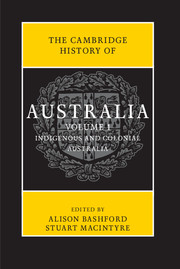Book contents
- Frontmatter
- Contents
- Abbreviations
- List of maps
- List of figures
- List of tables
- Notes on contributors
- Map
- Preface
- Introduction
- PART I
- PART II
- Further reading
- Chronology
- Index
- Frontmatter
- Contents
- Abbreviations
- List of maps
- List of figures
- List of tables
- Notes on contributors
- Map
- Preface
- Introduction
- PART I
- PART II
- 9 Religion
- 10 Culture and media
- 11 Science and medicine
- 12 Society and welfare
- 13 Gender and sexuality
- 14 Indigenous Australia
- 15 Class
- 16 The economy
- 17 Government, law and citizenship
- 18 Education
- 19 The environment
- 20 Travel and connections
- 21 Security
- 22 Australia, Britain and the British Commonwealth
- 23 Australia in the Asia-Pacfic region
- 24 The history anxiety
- Further reading
- Chronology
- Index
18 - Education
from PART II
Published online by Cambridge University Press: 05 November 2013
- Frontmatter
- Contents
- Abbreviations
- List of maps
- List of figures
- List of tables
- Notes on contributors
- Map
- Preface
- Introduction
- PART I
- PART II
- Further reading
- Chronology
- Index
- Frontmatter
- Contents
- Abbreviations
- List of maps
- List of figures
- List of tables
- Notes on contributors
- Map
- Preface
- Introduction
- PART I
- PART II
- 9 Religion
- 10 Culture and media
- 11 Science and medicine
- 12 Society and welfare
- 13 Gender and sexuality
- 14 Indigenous Australia
- 15 Class
- 16 The economy
- 17 Government, law and citizenship
- 18 Education
- 19 The environment
- 20 Travel and connections
- 21 Security
- 22 Australia, Britain and the British Commonwealth
- 23 Australia in the Asia-Pacfic region
- 24 The history anxiety
- Further reading
- Chronology
- Index
Summary
Formal education developed and expanded in twentieth-century Australia, responding constantly to the needs of an increasingly complex society. Different sectors with their roots in the nineteenth century became parts of a system conceived as a ‘ladder of opportunity’ carrying students from the earliest stages of learning to the most sophisticated. At the beginning of the century the state primary school had only recently been established, and the idea of progression to secondary school was still novel. Over the century Australia, in common with much of the developed world, moved from elementary to universal secondary education, and then to mass higher education.
By the century's end a progressively more global orientation in a networked world had come to shape a pattern of educational provision and of increased competition. New constituencies sought secondary and higher education: girls and women, children of the working class, and successive waves of immigrants keen to climb the ladder of opportunity that education promises. While the story is one of increasing participation, persistent patterns of exclusion remain. Indigenous children and young people, rural and regional students, and those from the poorest social groups still find educational qualifications elusive. These qualifications are vital as the youth labour market for unskilled workers has collapsed. Since the 1980s educational institutions of all kinds have been shaped by market competition and ‘quality assurance’. How did these changes take place, and in what circumstances?
1901 to World War 2
At the beginning of the twentieth century nearly all non-Indigenous children experienced at least five years of basic education. Each of the Australian colonies had established and consolidated government-run, mass, compulsory elementary schooling. Queensland was the last to legislate for compulsion, in 1900, and New South Wales and Tasmania were the last to remove public school fees, in 1906 and 1908 respectively. While school attendance was not enforced until the 1910s, the public elementary school was a fixture in nearly every suburb and town across the nation, and the routines of ‘efficient’ schooling an entrenched feature of Australian social life.
- Type
- Chapter
- Information
- The Cambridge History of Australia , pp. 429 - 451Publisher: Cambridge University PressPrint publication year: 2013
- 5
- Cited by

